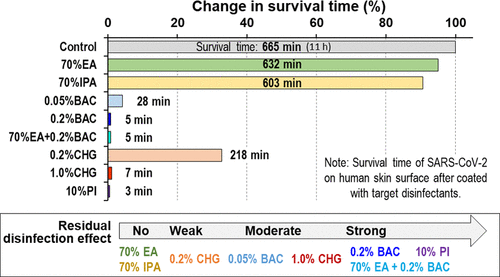
COVID-19:消毒薬の対ウイルス残留消毒効果:京都府立医科大(動画):
COVID-19:Disinfectant’s anti-virus residual disinfection effect:KPU-M:
COVID-19:消毒剂的抗病毒残留消毒效果:京都府立医科大学
~「ヒト皮膚上のウイルス生存時間」を「大幅に短縮する方法」~
研究成果:
- 消毒薬を手に塗布して乾燥した後、
- どの位消毒効果があるのか?
- 正確に評価できるモデルを構築した。
エタノールやイソプロパノールなど:
アルコール系消毒薬には、残留消毒効果がほとんど認められなかった。
一方、グルコン酸クロルヘキシジン・塩化ベンザルコニウムなどの消毒薬には、
残留消毒効果が認められた。
残留消毒効果を比較:
「比較的高濃度である0.2%塩化ベンザルコニウム」は特に強い残留消毒効果を示した。
- 新型コロナウイルス、
- ヒトコロナウイルス、
- インフルエンザウイルス、
それぞれの生存時間を
- 665分から5分(1%未満)、
- 1285分から12分(1%未満)、
- 121分から4分(3%)に短縮した。
この強い残留消毒効果は、皮膚に塗布した後、4時間にわたり維持された。
手指衛生を強力にサポート:
強い残留消毒効果を持つ消毒剤を皮膚に塗布する。
「これで、ウイルスが生存しにくい皮膚表面を創出すること」ができる。
現行の手指衛生を強力にサポートする。
革新的な接触感染予防法となることが期待される。
https://www.kpu-m.ac.jp/doc/news/2021/20211127.html
効果4時間の「奇跡の消毒剤」 日本研究チームが発見 Joongang Ilbo | 中央日報
https://s.japanese.joins.com/JArticle/285291?sectcode=400&servcode=400
Evaluation of the Residual Disinfection Effects of Commonly Used Skin Disinfectants against Viruses:
An Innovative Contact Transmission Control Method
Abstract
Lasting disinfection effects, that is, the residual disinfection effects (RDEs), of skin-coated disinfectants
have rarely been considered for infection control owing to the challenges involved in the accurate evaluation of RDEs.
In this study,
we constructed a new skin evaluation model and determined the RDEs of existing disinfectants against viruses.Our results showed that
ethanol and isopropanol had no RDE, whereas povidone–iodine, chlorhexidine gluconate, and benzalkonium chloride (BAC) exhibited RDEs,with 10% povidone–iodine and 0.2% BAC showing particularly strong RDEs.
The RDE of 0.2% BAC was strong enough to reduce
the median survival times of severe acute respiratory syndrome
coronavirus-2,
human coronavirus-OC43,
and influenza virus
from 670 to 5.2,
1300 to 12,
and 120 to 4.2 min, respectively.Additionally,
this strong RDE was maintained even 4 h after coating the skin.Clinical data also showed that the strong RDE of 0.2% BAC was maintained for more than 2 h.
Thus,
applying disinfectants with strong RDEs on the skin correlates with a reduction in virus survival timeand appears to create a skin surface environment that is not conducive to virus survival.
A prolonged reduction in virus survival decreases the contact transmission risk, thereby enabling stronger infection control.
Environmental Science & Technology